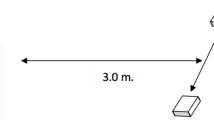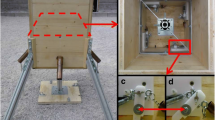Abstract
Deception, the use of false signals to modify the behaviour of the receiver, occurs in low frequencies even in stable signalling systems. For example, it can be advantageous for subordinate individuals to deceive in competitive situations. We investigated in a three-way choice task whether dogs are able to mislead a human competitor, i.e. if they are capable of tactical deception. During training, dogs experienced the role of their owner, as always being cooperative, and two unfamiliar humans, one acting ‘cooperatively’ by giving food and the other being ‘competitive’ and keeping the food for themselves. During the test, the dog had the options to lead one of these partners to one of the three potential food locations: one contained a favoured food item, the other a non-preferred food item and the third remained empty. After having led one of the partners, the dog always had the possibility of leading its cooperative owner to one of the food locations. Therefore, a dog would have a direct benefit from misleading the competitive partner since it would then get another chance to receive the preferred food from the owner. On the first test day, the dogs led the cooperative partner to the preferred food box more often than expected by chance and more often than the competitive partner. On the second day, they even led the competitive partner less often to the preferred food than expected by chance and more often to the empty box than the cooperative partner. These results show that dogs distinguished between the cooperative and the competitive partner, and indicate the flexibility of dogs to adjust their behaviour and that they are able to use tactical deception.

Similar content being viewed by others
References
Amici F, Call J, Aureli F (2009) Variation in withholding of information in three monkey species. Proc R Soc B 276:3311–3318. doi:10.1098/rspb.2009.0759
Anderson JR, Kuroshima H, Kuwahata H, Fujita K, Vick S (2001) Training squirrel monkeys (Saimiri sciureus) to deceive: acquisition and analysis of behaviour toward cooperative and competitive trainers. J Comp Psychol 115(3):282–293. doi:10.1037//0735-7036.115.3.282
Bálint A, Faragó T, Dóka A, Miklósi Á, Pongrácz P (2013) “Beware, I am big and non-dangerous!”—playfully growling dogs are perceived larger than their actual size by their canine audience. Appl Anim Behav Sci 148:128–137. doi:10.1016/j.applanim.2013.07.013
Baron-Cohen S (1999) Evolution of a theory of mind? In: Corballis M, Lea S (eds) The descent of mind: psychological perspectives on hominid evolution. Oxford University Press, Oxford
Bonanni R, Cafazzo S (2014) The social organisation of a population of free-ranging dogs in a suburban area of Rome: a reassessment of the effects of domestication on dogs’ behaviour. In: Kaminski J, Marshall-Pescini S (eds) The Social Dog: behaviour and cognition. Academic Press, London, pp 65–104
Bradshaw JW, Blackwell EJ, Casey RA (2009) Dominance in domestic dogs—useful construct or bad habit? J Vet Behav 4:135–144. doi:10.1016/j.jveb.2008.08.004
Bräuer J, Call J, Tomasello M (2004) Visual perspective taking in dogs (Canis familiaris) in the presence of barriers. Appl Anim Behav Sci 88:299–317. doi:10.1016/j.applainim.2004.03.004
Bugnyar Th, Kotrschal K (2002) Observational learning and the raiding of food caches in ravens, Corvus corax: is it “tactical” deception? Anim Behav 64:185–195. doi:10.1006/anbe.2002.3056
Byrne RW, Corp N (2004) Neocortex size predicts deception rate in primates. Proc R Soc B 271:1693–1699. doi:10.1098/rspb.2004.2780
Byrne RW, Whiten A (1988) Machiavellian Intelligence: Social Expertise and the Evolution of Intellect in Monkeys, Apes, and Humans. Oxford University Press, Oxford
Byrne RW, Whiten A (1992) Cognitive evolution in primates: evidence from tactical deception. Man (N.S.) 27(3):609–627
Cafazzo DA, Valsecchi P, Bonanni R, Natoli E (2010) Dominance in relation to age, sex, and competitive contexts in a group of free-ranging domestic dogs. Behav Ecol 21:443–455. doi:10.1093/beheco/arq001
Cheney DL, Seyfarth RM (1990) How monkeys see the world: Inside the mind of another species. University of Chicago Press, Illinois
Cooper JJ, Ashton C, Bishop S, West R, Mills DS, Young RJ (2003) Clever hounds: social cognition in the domestic dog (canis familiaris). Appl Anim Behv Sci 81:229–244. doi:10.1016/S0168-1591(02)00284-8
Coussi-Korbel S (1994) Learning to outwit a competitor in mangabeys. J Comp Psychol 108(2):164–171. doi:10.1037/0735-7036.108.2.164
Flower TP, Gribble M, Ridley AR (2014) Deception by flexible alarm mimicry in an African bird. Science 344(513):513–516. doi:10.1126/science.1249723
Fujita K, Kuroshima H, Masuda T (2002) Do tufted capuchin monkeys (Cebus apella) spontaneously deceive opponents? A preliminary analysis of an experimental food-competition contest between monkeys. Anim Cogn 5:19–25. doi:10.1007/s100710100099
Goodall J (1986) The chimpanzees of Gombe: patterns of behavior. Belknap Press, Cambridge
Gyger M, Marler PM (1988) Food calling in the domestic fowl, Gallus gallus: the role of external referents and deception. Anim Behav 36:358–365. doi:10.1016/S0003-3472(88)80006-X
Hare B, Call J, Tomasello M (2006) Chimpanzees deceive a human competitor by hiding. Cognition 101:495–514. doi:10.1016/j.cognition.2005.01.011
Hare B, Tomasello M (2005) Human-like social skills in dogs? Trends Cogn Sci 9(9):440–444. doi:10.1016/j.tics.2005.07.003
Hauser MD (1992) Costs of deception: cheaters are punished in rhesus monkeys (Macaca mulatta). Proc Natl Acad Sci USA 89:12137–12139
Hauser MD (1997) Minding the behaviour of deception. In: Whithen A, Byrne RW (eds) Machiavellian intelligence II extensions and evaluations. Cambridge University Press, Cambridge
Heberlein MTE, Turner DC, Range F, Virányi Z (2016) A comparison between wolves, Canis lupus, and dogs, Canis familiaris, in showing behaviour towards humans. Anim Behav 122:59–66. doi:10.1016/j.anbehav.2016.09.023
Heyes CM (1998) Theory of mind in nonhuman primates. Behav Brain Sci 21(1):101–134
Hirata S, Matsuzawa T (2001) Tactics to obtain a hidden food item in chimpanzee pairs (Pan tronglodytes). Anim Cogn 4:285–295. doi:10.1007/s100710100096
Johnstone RA, Grafen A (1993) Dishonesty and the handicap principle. Anim Behav 46:759–764
Kaminski J, Call J, Fischer J (2004) Word learning in a domestic dog: evidence for “fast mapping”. Science 304:1682–1683. doi:10.1126/science.1097859
Kaminski J, Neumann M, Bräuer J, Call J, Tomasello M (2011) Dogs, Canis familiaris, communicate with humans to request but not to inform. Anim Behav 82:651–658. doi:10.1016/j.anbehav.2011.06.015
Marler P, Dufty A, Pickert R (1986) Vocal communication in the domestic chicken: I. Does a sender communicate information about the quality of a food referent to a receiver? Anim Behav 34:188–193. doi:10.1016/0003-3472(86)90022-9
Mitchell RW, Anderson JR (1997) Pointing, withholding information, and deception in capuchin monkeys (Cebus apella). J Comp Psychol 111(4):351–361. doi:10.1037/0735-7036.111.4.351
Mitchell RW, Thompson N (1993) Familiarity and the rarity of deception: two theories and their relevance to play between dogs (Canis familiaris) and humans (Homo sapiens). J Comp Psychol 107(3):291–300. doi:10.1037/0735-7036.107.3.291
Petter M, Musolino E, Roberts WA, Cole M (2009) Can dogs (Canis familiaris) detect human deception? Behav Process 82:109–118. doi:10.1016/j.beproc.2009.07.002
Pongrácz P, Bánhegyi P, Miklósi Á (2012) When rank counts—dominant dogs learn better from a human demonstrator in a two—action test. Behaviour 149:111–132. doi:10.1163/156853912X629148
Pongrácz P, Vida V, Bánhegyi P, Miklósi Á (2008) How does dominance rank status affect individual and social learing performance in the dog (Canis familiaris)? Anim Cogn 11:75–82. doi:10.1007/s10071-007-0090-7
R Core Team (2014) R: a language and environment for statistical computing. R Foundation for Statistical Computing, Vienna, Austria. http://www.R-project.org/
Santos LR, Nissen AG, Ferrugia JA (2006) Rhesus monkeys, Macaca mulatta, know what others can and cannot hear. Anim Behav 71:1175–1181. doi:10.1016/j.anbehav.2005.10.007
Semple S, McComb K (1996) Behavioural deception. TREE 11(10):434–437
Steele MA, Halkin SL, Smallwood PD, Mckenna ThM, Mitsopoulos K, Beam M (2008) Cache protection strategies of a scatter-hoarding rodent: do tree squirrels engage in behavioural deception? Anim Behav 75:705–714. doi:10.1016/j.anbehav.2007.07.026
Tomasello M, Call J (1997) Primate cognition. Oxford University Press, New York
Virányi Z, Topál J, Gácsi M, Miklósi Á, Csányi V (2004) Dogs respond appropriately to cues of humans’ attentional focus. Behav Process 66:161–172. doi:10.1016/j.beproc.2004.01.012
Woodruff G, Premack D (1979) Intentional communication in the chimpanzee: the development of deception. Cognition 7:333–362. doi:10.1016/0010-0277(79)90021-0
Acknowledgements
We thank Dr. Sarah Marshall-Pescini, Prof. Dr. Kurt Kotrschal and Laura Stott for their comments on this manuscript, Judith Burkart for her discussion during preparation of the manuscript and two unknown referees for helpful comments on an earlier draft of this manuscript. Special thanks to Sandra Gross, Jennifer Morger, Ruth Hangartner and Linda Lüthi, who helped us a lot with conducting the experiments, Christina Mayer for inter-observer reliability coding, and many thanks to all dogs and their owners who voluntarily participated in this experiment. We thank Dr. Zsófia Virányi (Head of Clever Dog Lab, Co-Director of Wolf Science Center, Austria) for her contribution to the unpublished study: ‘showing—intentional communication—in dogs’, which is cited in this publication. Furthermore, we would like to thank Mars Switzerland Inc. in Zug for the dog biscuits and the presents for the dogs and their owners.
Author information
Authors and Affiliations
Corresponding author
Ethics declarations
Ethical approval
All procedures performed in this study involving animals were approved by the Zurich Cantonal Veterinary Department, concessionary number 07/2009, responsible for the ethical treatment of animals where the study was conducted, and the dog owners gave their informed consent before participating.
Informed consent
Informed consent was obtained from the dog owners, for subjects that participated in the study.
Rights and permissions
About this article
Cite this article
Heberlein, M.T.E., Manser, M.B. & Turner, D.C. Deceptive-like behaviour in dogs (Canis familiaris). Anim Cogn 20, 511–520 (2017). https://doi.org/10.1007/s10071-017-1078-6
Received:
Revised:
Accepted:
Published:
Issue Date:
DOI: https://doi.org/10.1007/s10071-017-1078-6




